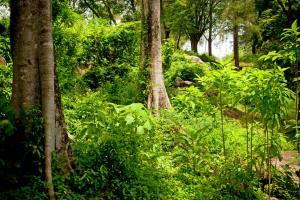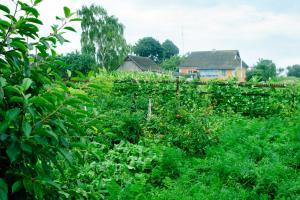One of the biggest challenges we collectively face as a species is how to grow sufficient food for our growing population. Large scale farming dependent on fossil fuel inputs, dangerous chemicals and genetically modified organisms has only increased our vulnerability. Food forests offer us an opportunity to revolutionize the way we grow our food, offering tremendous, diversified yields while capturing carbon from the atmosphere and increasing the ecological health of our environments.
The multiple challenges of our current food production system
For many decades now, we have been stuck in a dangerous cycle of unsustainable food production. The Green Revolution and its reliance on chemical inputs, large machines and technology did increase yields for a while, but at the expense of soil health and the overall condition of the farm ecosystem.
As the soil where we grow our food has continued to deteriorate in quality and fertility, our dependence on chemical and fossil fuel based agriculture becomes all the more deep-seated. As we near (or already pass) peak oil, depending on fossil fuels to provide the fertility for the foodstuffs we grow is obviously a dangerous proposition and increases our overall vulnerability.
In the years that come, one of the biggest challenges we face is how to grow enough food for a growing population while not depleting the ecological resiliency and health of the ecosystems that produce our food. The notion of food forests offer a unique opportunity to completely transform our food system from a system based on monocultures of annual crops that deplete the soil and harm the ecosystem to a polyculture of perennials that helps to heal some of the damages we have inflicted on the natural system.
What is a food forest?
Imagine looking out over a 1,000 acre cornfield. What may initially appear to be a sign of abundance is actually a symbol of our susceptibility to any number of problems. The endless acres of corn, wheat, soybeans, or any other staple crops of our industrial food civilization could very well be devoured by some sort of natural predator that grows because of the ecological imbalance that comes with monocultures. Once we run out of oil, the infertile ground left without anything but subsoil won’t grow much more than invasive weeds.
While those endless acres of grain and beans may appear to be incredibly productive, imagine now a forest of towering trees spaced just far enough apart to allow sunlight to penetrate the lower layers of the forest where smaller trees, bushes, and ground covers thrive.
Most everyone would agree that our forested landscape is obviously much more ecologically healthy and resilient than a cornfield. However, as the common wisdom goes, we need to eat and forests don’t offer much in the ways of food.
A food forest is a system of perennial plants established in such a way so as to mimic a natural forest ecosystem. With a food forest, however, many of the non-edible species that naturally occur in a forest are replaced through conscientious design with crops that bear yields that can help to sustain human life.
Food forests generally talk about taking advantage of the different “layers” where plants grow. Whereas a corn field or wheat field only grow food on one stratum or tier, a food forest tries to grow food crops on nine different layers or levels. Instead of only taking advantage of the horizontal space, food forests seek to increase yields through growing vertically as well as horizontally.
Since different types of plants grow best naturally in certain ecological niches, observation of a natural forest ecosystem can help you to design a system where plants can grow in mutually beneficial relationships.
 Most food forests talk of seven different layers to the food forest which we explain below.
Most food forests talk of seven different layers to the food forest which we explain below.
- Tall tree layer: This is the canopy layer of the forest and is made up of large fruit or nut trees. Depending on your climate, these can include pears, chestnuts, and pecans, among others. These need to be spaced sufficiently far apart to allow for enough light to pass through to the under layers of the food forest system.
- Low tree layer: The low tree layer is made up of smaller fruit and nut trees that are pruned so that they stay well below the canopy layer.
- Shrub layer: Below the pruned fruit and nut trees, different types of shrubs are planted that also offer significant yields. These shrubs can offer productive yields as well as nutrition to the forest system. Nitrogen bearing shrubs such as the Goumi tree or the Seaberry bush both offer delicious, nutrient packed berries while also providing the system with needed nitrogen that they take from the air and “fix” in their roots. In areas with heavy shade, certain fruit-bearing shrubs such as currants can thrive in partial to full shade.
- Herb layer: Below the shrubs, different types of herbs are grown. These not only offer important health benefits to humans, but also offer important functions to the ecosystem. For example, yarrow and dill plants have flowers that draw a number of important beneficial insects to help keep pests under control while the forest system gets started.
- Ground cover layer: One of the most important aspects of any sustainable food system is keeping the ground covered so that the soil can recover its natural fertility. In food forests, the ground covers are specifically chosen for the yields they offer. One example of a great ground cover is the mint species or creeping spinach which both form a thick mat on the forest floor while offering useful yields to humans.
- Vine layer: The tall tree lays and lower trees can both function as live trellises for vining species that also offer important food species. Even in cold climates, you can grow types of kiwi, passion fruit like paw-paws and other delicious fruit.
- Root layer: Lastly, the underground layer offers another opportunity to increase the yield from a particular piece of land. While many tubers may need full sunlight, some species can thrive in full shade. In places with wet and waterlogged soils, taro root is an excellent option.
The benefits a food forest offers
Instead of a one dimensional corn field that only offers one sort of crop, a food forest can significantly increase the yield in terms of calories per acre. The amounts of diversified products that grow in the seven different layers of a food forest also vastly improve the nutritional value of the different types of foodstuffs that can be harvested in any given space.
Whereas corn only offers a simple carbohydrate, a one acre food forest can offer protein from chestnuts growing in the canopy layer, vitamins and minerals from the variety of fruits growing in the lower trees and shrubs, medicinal plants in the herb and ground cover levels, and carbohydrates in root crops growing underneath the system. If you are able to inoculate fallen logs with shiitake mushrooms, you will also get another important food source high in protein and vitamins.
At the same time, the diversity of the system allows for a greater resiliency in your crop yields. Even if a certain type of pest wipes out one of your fruit crops, you will still be able to harvest a number of other crops from the same piece of land.
Additionally, the soil will continue to grow in fertility from the abundance of organic material that falls to the forest floor and slowly decomposes into a rich top soil.
In terms of labor, instead of having to annually till the soil and plant the corn crop, once the system is planted and established, the main tasks associated with a food forest are simple maintenance and harvesting your abundant yields.

How to plan, design, and plant a food forest
To plant your food forest, design is the most important aspect. You will need to first consider what species are best adapted to your specific climate and bioregion. While native species are usually preferable, exotics from other regions with similar climatic conditions can usually be introduced with considerable success.
One of the biggest mistakes when it comes to establishing a food forest is the temptation to overplant the system. When establishing a food forest on a barren piece of land, it can be hard to imagine the size of the trees and bushes in 10-20 years’ time. You can plant the tree species closer together with the understanding that you may need to cut back certain species from time to time (or remove them all together) if they are stealing sunlight from other species within the food forest system.
During the first year or two, you will need to make sure to control and cutback invasive species to allow the perennial tree and shrub crops to get established. A quality ground cover might need several plantings over the years in order to control unwanted invasive weeds that threaten to overtake the system.
Once your system is established (usually around the 3rd to 4th year), maintenance work might include periodic pruning, the removal of certain trees that aren’t producing as planned or that are outcompeting the rest of the system.
Food forests for the future
A landscape filled with a diversity of perennial crops is not only a more ecological option for our food needs, it also makes more sense from an efficiency and economic standpoint. With the proper patience and right design, a productive landscape offering nutritious, organic foods while contributing to the overall health of the ecological system is entirely possible.
